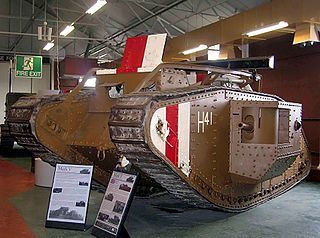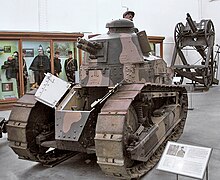
An armoured fighting vehicle or armored fighting vehicle (AFV) is an armed combat vehicle protected by armour, generally combining operational mobility with offensive and defensive capabilities. AFVs can be wheeled or tracked. Examples of AFVs are tanks, armoured cars, assault guns, self-propelled artilleries, infantry fighting vehicles (IFV), and armoured personnel carriers (APC).

A tankette is a tracked armoured fighting vehicle that resembles a small tank, roughly the size of a car. It is mainly intended for light infantry support and scouting. Colloquially it may also simply mean a small tank.

The TK (TK-3) and TKS were Polish tankettes developed during the 1930s and used in the Second World War.

The Vickers 6-ton tank or Vickers Mark E, also known as the "Six-tonner", was a British light tank designed in 1928 in a private project at Vickers. Though not adopted by the British Army, it was picked up by several other armed forces, and licensed by the Soviet Union as the T-26. It was also the direct predecessor of the Polish 7TP tank.

The Light Tank Mark I to Mark V were a series of related designs of light tank produced by Vickers for the British Army during the interwar period.

The AMC 35, also known under a manufacturer's designation Renault ACG-1, was a French medium cavalry tank of the later Interwar era that served in the Second World War. It was developed as a result of the change of the specification that had led to the design of the AMC 34, calling for a vehicle that was not only well-armed and mobile but also well-armoured. Due to technological and financial problems production was delayed and limited. The AMC 35 was one of the few French tanks of the period featuring a two-man turret.

The Carden Loyd tankettes were a series of British tankettes of the period between the World Wars, the most successful of which was the Mark VI, the only version built in significant numbers. It became a classic tankette design worldwide, was licence-built by several countries and became the basis of several designs produced in various countries.

Tanks were initially deployed in World War I, engineered to overcome the deadlock of trench warfare. Between the two world wars, tanks were further developed. Although they had demonstrated their battlefield effectiveness, only a few nations had the industrial resources to design and build them. During and after World War I, Britain and France pioneered tank technology, with their models generally serving as a blueprint for other countries. However, this initial advantage would slowly diminish during the 1930s, shifting in favor of the Soviet Union and, to a lesser degree, Nazi Germany.

Tanks were an important weapons system in World War II. Although tanks in the inter-war years were the subject of widespread research, few were made, in just a few countries. However, during World War II, most armies employed tanks, and thousands were built every month. Tank usage, doctrine, and production varied widely among the combatant nations. By war's end, a consensus was forming on tank doctrine and design.

The Type 92 heavy armoured car, also known as the Type 92 cavalry tank, was the Empire of Japan's first indigenous tankette. Designed for use by the cavalry of the Imperial Japanese Army by Ishikawajima Motorcar Manufacturing Company, the Type 92 was designed for scouting and infantry support. The Type 92 was thin armored and lightly armed. Although actually a light tank, it was called sōkōsha in Japanese due to political sectionalism within the Japanese Army. Exactly the same device was used in America with the M1 Combat Car.

The L3/35, also known as the Carro Veloce CV-35, was an Italian tankette that saw combat before and during World War II. Although designated a light tank by the Italian Army, its turretless configuration, weight and firepower make it closer to contemporary tankettes. It was the most numerous Italian armoured fighting vehicle and saw service almost everywhere the Italians fought in the Second World War but proved inadequate for modern warfare, having too thin armour and weak armament of only machine guns. It was cheaply produced but because of its light armaments and armour it was reserved to mostly colonial, policing, reconnaissance, and supply duties. However, given its low production costs, proved to be efficient in the Second Italo-Abyssinian War, Spanish Civil War and the Greco-Italian War where it provided reliable support to Italian infantry and disrupted enemy lines.

The Tančík vz. 33 was a Czechoslovak-designed tankette used mainly by Slovakia during World War II. Seventy-four were built. The Germans seized forty when they occupied Bohemia-Moravia in March 1939; there is no record of their use. The Slovak Republic inherited thirty at the same time when it declared independence from Czechoslovakia. In Slovak service it only saw combat during the Slovak National Uprising.

A light tank is a tank variant initially designed for rapid movements in and out of combat, to outmaneuver heavier tanks. It is smaller with thinner armor and a less powerful main gun, tailored for better tactical mobility and ease of transport and logistics. They are primarily employed in the screening, armored reconnaissance, skirmishing, artillery observation, and supplementing landing operations in a fire support role of expeditionary forces where larger, heavier tanks are unavailable or have difficulties operating safely or efficiently.

The Vickers T-15 light tank, full designation Char Léger de Reconnaissance Vickers-Carden-Loyd Mod.1934 T.15, was a light 4-ton tank of the Belgian Army. They were built by Vickers-Armstrong in the UK to the design of their Light Tank Mark III and outfitted with their armament in Belgium by Fonderie Royale de Canons (FRC) at Herstal. It entered service in 1935, and was used by the Belgian Army during the Battle of Belgium in May 1940. Its main armament was a 13.2 mm Hotchkiss machine gun. The tank was intended as a replacement for the venerable but obsolescent Renault FT. Only 42 were produced.

This article deals with the history of tanks employed by military forces in Czechoslovakia from the interwar period, and the more conventional tanks designed for the Czechoslovak Army before World War II, and the tanks that ended up as Panzers of the German Wehrmacht during World War II, or in the use of other countries who purchased them before the war began.

Tanks have been employed by the military forces in Italy since their first use in World War I. They have had continued use in wars after and are still used through the modern day. The C1 Ariete is the current main battle tank of the Italian Army.

The T-13 was a tank destroyer in use with the Belgian armed forces before World War II and during the Battle of Belgium. It was designed by Vickers-Armstrong, and produced by Vickers, Miesse and Familleheureux and outfitted with armament from Fonderie Royale de Canons Herstal. The earlier T-13s were based on imported Vickers tracked vehicles that were outfitted with armament and armor in Belgium by the Miesse company; later versions, from the B3 version on, were fully license-produced in Belgium by the Familleheureux factory. Total production numbers are unclear and have been underestimated for political reasons, both before and after World War II, but are generally estimated at 300 vehicles, although not all were available or fully outfitted on 10 May 1940, the start of the Battle of Belgium. Nazi Germany used the vehicles after the occupation of Belgium, but to what extent remains unclear.

The Vickers Light Dragon was a fully-tracked British field artillery tractor made by Vickers-Armstrongs Ltd from 1929 to 1935. Designed to tow small-calibre field guns, it complemented Vickers' Medium Dragon tractor, which pulled medium to heavy artillery.




















